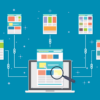Creating a mobile app from scratch can be an exciting yet challenging endeavor, especially for beginners entering the vast world of app development. Whether you have a groundbreaking app idea or are eager to gain hands-on experience, at Nexaplaystudios, in this comprehensive guide will walk you through the key steps of building an app, from conceptualization to deployment.
By breaking down the process into manageable stages, you’ll gain valuable insights into the fundamentals of app development and set the foundation for a successful project.
1. Define Your App Idea:
Conceptualization:
- Identify a Problem or Need: Start by identifying a problem or fulfilling a need within a specific target audience. Successful apps often address real-world challenges or provide solutions that enhance user experiences.
- Market Research: Conduct thorough market research to understand existing solutions, identify competitors, and uncover opportunities for innovation. Analyze user reviews to learn from existing products and discover pain points.
- Unique Selling Proposition (USP): Clearly define your app’s unique selling proposition—what sets it apart from competitors. Whether it’s a unique feature, a better user experience, or a niche target audience, your app should offer something distinctive.
2. Wireframing and Design:
Wireframing:
Create a Basic Sketch: Use wireframing tools or pen and paper to sketch a basic outline of your app’s user interface (UI). Focus on the layout, navigation flow, and essential elements on each screen.
User Flow: Map out the user flow, outlining how users will navigate through the app. Define the primary user actions and the logical sequence of screens they will encounter.
Design:
- Visual Design: Once the wireframe is finalized, move on to the visual design phase. Choose a color scheme, define your app’s branding elements, and create high-fidelity designs for each screen using graphic design tools.
- Prototyping: Develop interactive prototypes to visualize the app’s functionality. Prototyping tools allow you to simulate user interactions and gather feedback on the design before moving to development.
3. Choose the Right Technology Stack:
Frontend Development:
Native vs. Cross-Platform: Decide whether you want to build a native app (specific to a single platform like iOS or Android) or a cross-platform app (compatible with multiple platforms using frameworks like React Native or Flutter).
- Programming Languages: Choose the programming languages based on your platform:
- IOS (Swift or Objective-C): If building for iOS.
- Android (Java or Kotlin): If building for Android.
Backend Development:
- Server-Side Language: Select a server-side language for building the backend. Common choices include Node.js (JavaScript), Python, Ruby, or Java.
- Database: Choose a database system (e.g., MongoDB, MySQL, PostgreSQL) based on your app’s data requirements.
- APIs: Design and develop APIs to facilitate communication between the frontend and backend components of your app.
4. Actual Development:
Frontend:
- Setup Development Environment: Install the necessary development tools, SDKs, and frameworks based on your chosen technology stack.
- Write Code: Begin coding the front end of your app, implementing the designs and user flows. Utilise version control tools (like Git) to monitor modifications and work together with others.
Backend:
- Server Setup: Set up your server environment, ensuring it meets the requirements of your chosen backend technologies.
- Database Implementation: Create the database structure and implement data models. Establish connections between the server and the database.
- API Development: Build APIs to handle requests from the front end, including authentication, data retrieval, and updates.
5. Testing:
Unit Testing:
Conduct unit testing for individual components to ensure they function as intended. Use testing frameworks specific to your chosen programming languages.
Integration Testing:
Test the integration between frontend and backend components. Verify that data flows seamlessly between the user interface and the server.
User Acceptance Testing (UAT):
Gather feedback from potential users or a select group of beta testers. Identify and address any usability issues, bugs, or areas for improvement.
6. Refinement and Iteration:
Feedback Loop:
Use feedback from the testing phases to iterate on your app. Address issues, refine the user interface, and enhance functionality based on user suggestions.
Performance Optimization:
Optimize your app’s performance, addressing any bottlenecks or inefficiencies in the code. Consider factors such as load times, responsiveness, and resource utilization.
7. Security Considerations:
Data Encryption:
Implement secure data transmission by using encryption protocols (HTTPS) to protect user data during communication between the app and the server.
User Authentication:
Implement robust user authentication mechanisms, such as OAuth or JWT, to secure user accounts and protect sensitive information.
Code Review:
Conduct thorough code reviews to identify and address potential security vulnerabilities. Ensure that your code follows best practices and industry standards for security.
8. Prepare for Launch:
App Store Guidelines:
Familiarize yourself with the guidelines of the app stores (Apple App Store, Google Play Store) to ensure your app complies with their requirements.
App Store Submission:
Prepare all necessary assets (icons, screenshots, descriptions) and submit your app to the respective app stores for review.
Marketing and Promotion:
Develop a marketing strategy to promote your app. Utilize social media, create a website, and leverage other channels to generate awareness and attract users.
9. Launch and Post-Launch Activities:
Monitor Performance:
Monitor the app’s performance post-launch, keeping an eye on user engagement, feedback, and any potential issues.
Update and Maintenance:
Regularly update your app with new features, bug fixes, and improvements based on user feedback. Ensure that your app remains compatible with the latest devices and operating system versions.
User Support:
Provide responsive user support to address inquiries, troubleshoot issues, and maintain a positive relationship with your user base.
10. Learn and Iterate:
Reflect on the Experience:
Reflect on the entire app development process. Consider what worked well, what could be improved, and what lessons you’ve learned.
Continuous Learning:
Stay updated on new technologies, frameworks, and best practices in app development. Embrace a mindset of continuous learning to refine your skills and approach to future projects.
Conclusion:
Building an app from scratch is a rewarding journey that requires dedication, creativity, and a willingness to learn. By following this beginner’s guide, you’ve gained insights into the crucial steps of app development—from defining your idea to launching your app into the digital marketplace. Remember that the learning process doesn’t end with the completion of your first app; it’s an ongoing journey of improvement and innovation.
As you embark on your app development adventure, remain curious, seek guidance from experienced developers, and leverage the wealth of online resources and communities available. Whether you’re developing apps for personal projects, entrepreneurial ventures, or contributing to the tech ecosystem, the skills you acquire along the way will serve as a solid foundation for your future endeavors. Happy coding!


